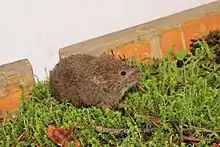Mexican vole
The Mexican vole (microtus mexicanus) is a rodent that has similar characteristics to a mouse. The Hualapai Mexican vole (M. m. hualapaiensis) were previously listed on the endangered species list and have been removed since July 24th, 2017 from its original listing on October 1st, 1987. They are known to have a cinnamon-brown coat, with a short tail and long fur. There are 3 main subspecies of the mexican voles: Hualapai Mexican vole (M. m. hualapaiensis), Navajo Mexican vole (M. m. Navaho), and Mogollon Mexican vole (M. m. mogollonesis). The Navajo Mexican vole has a longer body, tail and skull that is also broader. The Mogollon Mexican vole is similar to the Hualapai Mexican vole, but has brownish-gray fur.
| Mexican vole | |
|---|---|
 | |
| Scientific classification | |
| Kingdom: | Animalia |
| Phylum: | Chordata |
| Class: | Mammalia |
| Order: | Rodentia |
| Family: | Cricetidae |
| Subfamily: | Arvicolinae |
| Genus: | Microtus |
| Species: | M. mexicanus |
| Binomial name | |
| Microtus mexicanus (Saussure, 1861) | |
| Synonyms | |
| |
Distribution
Each of the Subspecies of the Mexican vole have different places of inhabitation. For example, the Hualapai Mexican voles are found in Arizona in the northwestern region in the mountain range. The Navajo Mexican voles can be found in San Francisco peaks in California and the Grand Canyon located in Arizona. The Mogollon Mexican voles are only found in Guadalupe Mountains National Park which is in the state of Texas.
Habitat and Ecology
The Mexican Vole is most commonly found in New mexico, Arizona, Mexico, and portions of colorado. Due to them being located in these areas the Mexican Vole lives in grasslands, and depending on the subspecies they like different types of climates. The Mogollon Mexican Voles like the less dry climate, and stay around where there is a fair amount of precipitation. The other Voles seem to prefer a dryer, and warmer climate than the Mogollon Mexican Vole. Given the amount of environments that the Mexican Voles live in, it shows that the vole is highly adaptable, and helps the survival species in how adaptable it is. This will also help the species with survival of natural phenomena that may occur in the surrounding area.
Morphology
The Mexican Vole is a small mammal, with an average size of about 4 inches. It's a quadrupedal mammal, with a long tail. The Mexican Vole also has fur on its body, to keep it warm. Different subspecies of the Mexican Vole seem to have slight differences to their structures. The Hualapai Mexican Vole is slightly longer body, tail, and skull then the Navajo Mexican Vole. The Navajo subspecies has a slightly longer body, tail, and skull than the Mogollon Mexican Vole.
Food sources
The Mexican vole mainly feeds on grass and the roots of various plants that include but are not limited to shrubs and trees within its immediate vicinity. (Beacham, 2000) Due to its herbivorous diet, it is usually found in places with plant life dominated by green vegetation. In several studies, the Mexican vole was baited using two plant products, barley and oatmeal. (Hilton, 1992) Although voles in general have herbivorous tendencies, a study done in 1985 has shown that the subspecies, Microtus mexicanus salvus, consumed monarch butterflies. (Brower,1985)
Discovery
The earliest discovery of the Mexican vole dates back to 1861 by Henri de Saussure, a Swiss entomologist. Microtus mexicanus mogollonensis was first recorded in 1890, Microtus mexicanus hualpaiensis in 1938, and the Microtus mexicanus navaho in 1934, upon the realization that different morphologies exist within this species. The various subspecies were found dispersed across the midwestern region of the United States and in Mexico. Information about several more uncommon species, such as Microtus mexicanus subsimus, salvus, or neveriae can be found on the global biodiversity information facility.
References
- Tsytsulina, K.; Formozov, N. & Sheftel, B. (2008). "Microtus mexicanus". IUCN Red List of Threatened Species. 2008. Retrieved 22 June 2009.CS1 maint: ref=harv (link)
Hilton, Barry L. “Reproduction in the Mexican Vole, Microtus Mexicanus.” Journal of Mammalogy, vol. 73, no. 3, 1992, pp. 586–590. JSTOR, www.jstor.org/stable/1382029. Accessed 3 Nov. 2020.
"Hualapai Mexican Vole." Beacham's Guide to the Endangered Species of North America, edited by Walton Beacham, et al., vol. 1: Mammals, Birds, Reptiles, Gale, 2000, pp. 206-208. Gale eBooks, https://link.gale.com/apps/doc/CX3400600069/GVRL?u=sunysb&sid=GVRL&xid=8c5bcb08. Accessed 3 Nov. 2020.
Endangered and Threatened Wildlife and Plants; Removal of the Hualapai Mexican Vole From the Federal List of Endangered and Threatened Wildlife. (2017, June 23). Retrieved November 03, 2020, from https://www.federalregister.gov/documents/2017/06/23/2017-13162/endangered-and-threatened-wildlife-and-plants-removal-of-the-hualapai-mexican-vole-from-the-federal
Davis, Russell and Callahan, J. R. (1992) "Post-pleistocene dispersal in the Mexican vole (Microtus mexicanus): an example of an apparent trend in the distribution of southwestern mammals," Great Basin Naturalist: Vol. 52 : No. 3 , Article 8. Available at: https://scholarsarchive.byu.edu/gbn/vol52/iss3/8
Johnson, V. (2017). Endangered and Threatened Wildlife and Plants; Removal of the Hualapai Mexican Vole From the Federal List of Endangered and Threatened Wildlife. Federal Register, 82(120), 28582-28588. Retrieved November 3, 2020, from https://www.federalregister.gov/documents/2017/06/23/2017-13162/endangered-and-threatened-wildlife-and-plants-removal-of-the-hualapai-mexican-vole-from-the-federal#:~:text=The%20three%20subspecies%20of%20Mexican,%2C%20Navajo%20Mexican%20vole%20(M. Brower, Lincoln P., et al. “Mice (Peromyscus Maniculatus, P. Spicilegus, and Microtus Mexicanus) as Predators of Overwintering Monarch Butterflies (Danaus Plexippus) in Mexico.” Biotropica, vol. 17, no. 2, 1985, pp. 89–99. JSTOR, www.jstor.org/stable/2388500. Accessed 3 Nov. 2020.
Microtus mexicanus (Saussure, 1861) in GBIF Secretariat (2019). GBIF Backbone Taxonomy. Checklist dataset https://doi.org/10.15468/39omei accessed via GBIF.org on 2020-11-03
Microtus mexicanus subsp. navaho Benson, 1934 in GBIF Secretariat (2019). GBIF Backbone Taxonomy. Checklist dataset https://doi.org/10.15468/39omei accessed via GBIF.org on 2020-11-03.
Microtus mexicanus subsp. hualpaiensis Goldman, 1938 in GBIF Secretariat (2019). GBIF Backbone Taxonomy. Checklist dataset https://doi.org/10.15468/39omei accessed via GBIF.org on 2020-11-03.
Microtus mogollonensis (Mearns, 1890) in GBIF Secretariat (2019). GBIF Backbone Taxonomy. Checklist dataset https://doi.org/10.15468/39omei accessed via GBIF.org on 2020-11-03.
